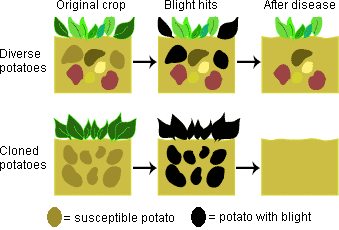Potential Results
It is said that history repeats itself, and while this is not precisely true, the patterns of history certainly seem to offer a perspective on current events. In 1845, the Irish Potato Famine, which would kill and displace millions, began. The Irish peasantry relied on potatoes as their staple food source; more specifically, they relied primarily on one variety, the Lumper potato brought over from the Andes in the 1500's by the Spanish. In 1845, the fungus Phytophthora infestans, also from the Andes, began to spread across Ireland, destroying nearly all Lumper potato plants (Siebert).
In a more recent historical example, the Southern Corn Leaf Blight caused a production loss of over a billion dollars in 1970. A new hybrid variety of corn, the "Texas male sterile" (TMS), was released. Bred to be resistant to most common corn diseases, but lacking resistance to the Southern Corn Leaf Blight, corn with the TMS trait accounted for about 90% of the corn that was planted. Thus, once the blight appeared, it spread easily through the monoculture of susceptible plants with few barriers of resistant varieties (Muir). Thankfully, scientists found that by incorporating a gene found in Mayorbella, an African corn variety, they could make commercial varieties resistant to the blight, averting a larger catastrophe (Harvesting).

The Dangers of Monocultures
Today, many of the staple food crops are planted in vast monocultures, much like the Irish planting of Lumper potatoes prior to the Potato Famine. And since the monocultures are genetically identical, they are all susceptible to the same diseases. For example, stem rust, or Puccinia graminis, is a fungus destructive to many varieties of wheat. In 1999, a new strain of it, dubbed Ug99, was identified in Uganda. It has since spread to other countries in eastern Africa as well as Yemen and Iran. It is feared that it will continue to spread, to India and Pakistan, then to Russia and China. With the amount of international travel occurring today, it would take just a single spore of Ug99 on an airplane passenger's shoe for it to reach the United States. About 90% of the world's wheat is susceptible; in the US alone, a billion dollars worth of wheat would be at risk (Siebert). The graph at left shows the estimated percentages of the world wheat crop that will come from these susceptible areas.

The effects of global warming, in combination with the decreasing diversity of crops, pose an additional threat to the world food supply. Global climate change is expected to increase average global temperatures (while causing some areas of the world to become colder), cause changes in weather patterns that will increase drought in some regions of the world, and lead to rising sea levels, which may cause the intrusion of salt water into freshwater aquifers that are used for crop irrigation. These climate changes may also cause alterations of the type and intensity of pest and disease problems (Muir).
The Intergovernmental Panel on Climate Change (IPCC) has, in its Special Report on Emissions Scenarios (SRES), developed several different models for what global emissions and climate change may look like at the end of the century, based on different economic and technological scenarios. Above are three maps of expected global changes in grain production by 2080, based on these scenarios. Below are descriptions of the three scenarios, as described in their simplest form by the IPCC.
- A1F1: "A future world of very rapid economic growth, low population growth and rapid introduction of new and more efficient technology. Major underlying themes are economic and cultural convergence and capacity building, with a substantial reduction in regional differences in per capita income. In this world, people pursue personal wealth rather than environmental quality." (Scenario)
- A2: "A very heterogeneous world. The underlying theme is that of strengthening regional cultural identities, with an emphasis on family values and local traditions, high population growth, and less concern for rapid economic development." (Scenario)
- B2: "A world in which the emphasis is on local solutions to economic, social, and environmental sustainability. It is again a heterogeneous world with less rapid, and more diverse technological change but a strong emphasis on community initiative and social innovation to find local, rather than global solutions." (Scenario)






Images from: <http://sedac.ciesin.org/wdc/map_gallery.jsp>
For further models, specific to the production of particular types of grains, go to the website above.

With fears of a global catastrophe abounding, be it caused by global warming, an epidemic of plant blight, or even nuclear war, the Svalbard Global Seed Vault was built in 2006 (Tepper), in the hope that enough biological diversity can be preserved to create new varieties suited to future climates and situations.

The Svalbard Global Seed Vault

The Diminishing Seed Pool